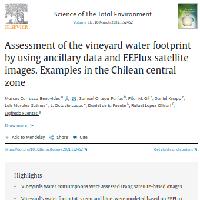Resumen
-
The increase of vineyard's water consumption due to the Global Warming Phenomenon (GWP) has forced the winegrowers to strengthen their irrigation and water stewardship efforts, intended for maintaining this resource's long-term sustainable use. Due to water being a limited resource, implementing the Water Footprint (WF) concept in winegrapes production provides helpful information for sustainable water stewardship. Currently, an automated version of the satellite-based METRIC (Mapping Evapotranspiration with Internalized Calibration) model, the Google Earth Engine Evapotranspiration Flux (EEFlux) platform, has been suggested as an alternative to analyzing the spatial variability of an entire field's water consumption throughout the growing season. This work aimed to evaluate the potential application of the EEFlux satellite's actual evapotranspiration (ETa) products and ancillary field data to obtain the WF blue (WFb) and green (WFg) of six commercial vineyards placed in the Chilean central zone. Firstly, the reliability of the daily actual evapotranspiration data from EEFlux (ETa EEFlux) was assessed against measured ETa data, using an available database from previous studies.
The results of ETa EEFlux estimations against measured ETa were impressive, presenting a root square error (RMSE) of 0.8 mm day−1. The satellite-derived crop coefficients (Kc Sat) allowed to estimate the total WF of each vineyard, in a range of 200 to 900 m3 t−1, showing an average relative error (RE) of 101%, between the satellite-based WFb (WFb Sat) and those calculated from irrigation records (WFb). These results reflected the particular conditions of each vineyard and can be considered reasonable since they were estimated from ancillary data and EEFlux products. This study provides new insights that may represent opportunities to sustainably managing the irrigation of vineyards.
